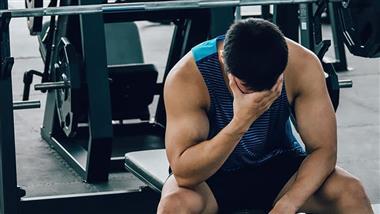
Story at-a-glance
- Exercise headaches affect up to 26% of adults and occur even when properly hydrated, often due to how the brain manages heat during physical exertion
- Your brain cools itself by increasing blood flow, which raises pressure in your skull that triggers headaches, especially if you’re new to exercise or increase intensity too quickly
- Warning signs include vision problems, nausea or thunderclap headaches that come on suddenly; these require medical evaluation to rule out serious conditions
- Prevention strategies include warming up slowly, staying well-hydrated before and during workouts, exercising in cool environments and gradually building fitness levels
- Most exercise headaches are harmless and typically improve over time as your cardiovascular system adapts to physical stress
It’s common to be perfectly hydrated and still get hit with a brutal headache right after a workout. For some, it starts as a subtle throb on both sides of the head. For others, it’s a sudden pounding that stops them in their tracks. These are known as exercise-induced headaches, which some describe as “the worst headache of my life.” They affect up to 26% of adults, depending on the study.1
While exercise headaches don’t always mean something is seriously wrong, they’re also not something to brush off. When your brain sends up a signal like that, it’s worth listening. What’s frustrating is how unpredictable they often feel. You drink water, fuel properly, get enough sleep and still end up sidelined by pain. So, what’s actually going on?
The answer has less to do with how hydrated you are and more to do with how your body regulates pressure and blood flow under stress. You don’t need to give up your workouts to stop the cycle. You just need to understand what’s driving these headaches in the first place. That’s where the science comes in.
Exercise Headaches Happen When Your Brain Gets Too Hot
An article in The Conversation explored why some people develop exertion headaches despite staying hydrated and exercising regularly.2 It examined current theories and findings to help explain what’s actually going on inside your body when these headaches strike.
• Exercise headaches affect people differently based on how fit they are — These headaches are more common in people new to intense workouts or those who ramp up too fast. They usually happen after a physically demanding session. But what’s considered “strenuous” really depends on your current fitness level, so even moderate effort could trigger them if you’re not yet adapted.
• The pain lasts from a few minutes to two full days — However, they sometimes go away in time. The article notes that some people stop getting these headaches after a few months of consistent training. That’s because your cardiovascular system slowly becomes better at handling physical stress and regulating blood flow to your brain.
• A key cause appears to be how your brain handles heat — Unlike the rest of your body, your brain doesn’t sweat. To cool down, it redirects more blood flow to your head during exercise. This creates higher pressure in your skull, which triggers pain.
Further, during exercise, your arteries and veins widen to deliver more blood and oxygen to your muscles and organs. The same thing happens in your brain, but in a confined space, this creates extra pressure, especially when you’re already hot or dehydrated. When it’s hot outside, your body sends even more blood to your brain in an attempt to cool it down. This overcompensation results in increased intracranial pressure and worsens the headache.
• Dehydration compounds the problem, but isn’t always the main trigger — While many people assume they’re getting these headaches from not drinking enough water, hydration alone isn’t the whole story. However, dehydration puts extra stress on your cardiovascular system, which could make your brain’s cooling response more aggressive — and more painful.
• Gradual fitness improvements reduce headache risk over time — People who build up slowly tend to report fewer and milder exercise headaches, likely because their blood vessels become more efficient at dilating and contracting with less pressure buildup.
Vision Problems and Nausea Are Red Flags You Shouldn’t Ignore
Although most exercise headaches are harmless, some are tied to dangerous conditions like brain hemorrhages, infections or elevated brain pressure.3 If you’re experiencing these headaches for the first time, or if they’re sudden and severe, you should get evaluated. The Cleveland Clinic also broke down how exertion headaches differ from typical head pain.4
• Some symptoms mimic migraines and need to be taken seriously — While throbbing pain on both sides of the head is common, the Cleveland Clinic highlights more serious symptoms like vision changes, nausea and vomiting. If you’re seeing blind spots, getting dizzy or feeling sick to your stomach after workouts, that’s not something to push through.
• Unlike general tension headaches, exertion headaches often feel like a strong pulsing sensation — This typically builds quickly during or after physical activity. They also sometimes feel like a thunderclap — sudden and explosive. These details matter because understanding your symptoms helps you communicate more clearly with your doctor if you need to seek help. Underlying conditions are rare but important to rule out.
• If you’ve never had one before, don’t brush it off — First-time exertion headaches, especially if severe or paired with other neurological symptoms, should be evaluated by a medical professional. Confusion, fainting, extreme drowsiness or a headache that lasts more than two days are all red flags.
Once you understand what’s triggering your symptoms and get the green light from your doctor, you’ll be more confident about pushing forward with your workouts without worrying about the next headache hitting out of nowhere.
Why Pushing Too Hard Too Soon Sets You Up for Headaches
According to Dr. Ashhar Ali, a neurologist at Henry Ford Health, starting a workout program too aggressively runs the risk of causing your brain and body to react negatively.5 If your system isn’t yet conditioned for exertion, the added pressure from overexertion could show up as a headache. The fix is simple but requires patience: start slow and give your body time to adapt.
• Dehydration is a major driver of head pain — While it’s possible to get an exercise headache even if you drink plenty of water, Ali emphasizes the systemic impact of dehydration on your brain. It doesn’t just leave you tired, it alters fluid balance, increases body strain and heightens the chances of blood vessel dilation in your head, triggering that pounding sensation. “Headaches are another side effect of not drinking enough water,” he warns.6
• Heat overload during workouts makes things worse — Exercising in hot environments, whether outdoors in direct sun or indoors with poor airflow, is another trigger. What’s more, your clothing choice matters. Heavy fabrics, dark colors or non-breathable materials trap heat and force your body to work harder to cool down. That extra burden increases pressure in the brain, leading to pain.
• Altitude training isn’t for everyone, and it’s a problem if you’re not used to it — Working out at higher elevations, especially while traveling, is a serious headache trigger. The oxygen is thinner at higher altitudes, and your brain has to work harder to compensate.
For people not acclimated to these conditions, the change in oxygen pressure often results in sharp, exertion-related headaches. Ideally, take a few days to adjust before attempting intense exercise in these conditions.
• These headaches are often mistaken for something else — People frequently misattribute these headaches to stress or muscle tension, when in fact, it’s the training environment and pace that’s to blame. This misdirection leads many to overlook simple fixes like resting, hydrating, staying cool or adjusting their workout intensity.
How to Stop Headaches from Derailing Your Workouts
If you’re dealing with headaches after a strength-training session, or even just an intense walk, it’s not in your head, at least not the way you think. The problem isn’t always hydration or a poor night’s sleep. Often, it’s how your brain responds to overheating, overexertion or sudden pressure changes.
The good news? You don’t have to live with it, and you don’t have to quit your workouts either. These are direct ways to fix the root of the issue and keep your head clear while you train. Here’s what I recommend if you’re trying to avoid exercise-induced headaches:
1. Start with a slow warm-up and build intensity over time — You wouldn’t go from zero to sprint in five seconds, and your brain doesn’t like it either. Give your blood vessels time to adapt by easing into your workout. Start with gentle movements, low weights or a light walk. If you’ve been sedentary or are just getting back into fitness, your body needs time to relearn how to regulate pressure and blood flow.
2. Fix your hydration before, during and after training — If you’re even slightly dehydrated, your body has to work harder to pump blood, especially to your brain. That raises your risk for pain. Don’t just sip water once your headache starts, get ahead of it. Drink throughout the day, not just right before or during your session.
If you sweat a lot or train outside, you’ll want to consider a mineral-rich hydration option like coconut water or a homemade mix of water, sea salt and fruit juice to replenish what you lose. Overall, just listen to your thirst. A good rule of thumb is to check your urine. It should be a pale yellow color — if it’s dark, you’re dehydrated.
3. Control your workout environment — If you’re exercising in a hot, stuffy room or wearing heavy or dark-colored clothes, you’re setting yourself up for overheating. Switch to natural breathable fabrics and avoid workouts in extreme heat. If you’re indoors, use a fan or open a window. Your brain doesn’t cool itself like your skin, so anything that prevents heat buildup helps protect you.
4. Adjust your workouts at high altitude or during travel — If you’re in the mountains or somewhere with thinner air, your brain is working overtime just to get enough oxygen. It’s easy to push too hard without realizing it. If you’re not used to high elevations, avoid intense training the first few days. Focus on lower-impact options like walking, yoga or light bodyweight exercises while your body adjusts.
FAQs About Exercise Headaches
Q: Why do I get a headache after working out, even when I drink water?
A: Exercise headaches aren’t always caused by dehydration alone. Your brain can’t cool down by sweating like the rest of your body, so it sends more blood to your head to regulate temperature. That increases pressure inside your skull, which triggers pain, especially if you ramp up intensity too fast.
Q: Are exercise-induced headaches dangerous?
A: Most of the time, no. They usually fade within a few hours to two days and tend to improve over time as your cardiovascular system adapts. However, if it’s your first headache, or if the pain is sudden and severe, lasts longer than two days or comes with symptoms like nausea, vision changes or confusion, you should get checked to rule out more serious conditions.
Q: Who is most likely to get these headaches?
A: People who are new to intense workouts, pushing too hard too fast, training in high heat or altitude, or wearing heat-trapping clothes are more likely to experience exercise headaches. Dehydration and poor conditioning are also major contributors.
Q: How do I stop these headaches from happening again?
A: Start with a slow warm-up, stay hydrated throughout the day, train in a cool environment and avoid high-intensity workouts in extreme heat or thin air.
Q: What symptoms should I look out for?
A: Red flags include a thunderclap headache (sudden and extreme pain), fainting, stiff neck, confusion, vomiting or vision issues. If any of these show up, or if the headache lasts more than 48 hours, it’s important to get evaluated for more serious conditions like vascular spasms or brain bleeds.
Source: Original Article
Publish Date: 2025-06-16 06:00:00

